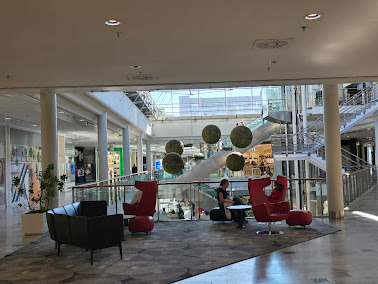Regal Princess/Port of LeHavre/Honfleur
Saturday, October 5, 2024
Sunny,
57F
I have been in
LeHavre twice before today—it is the port where I arrived from NYC off the
Holland America Rotterdam in 1967 with my trunk and suitcase, eagerly
anticipating my year of studies in France.
My first remembrance of France is that there was no bus to take the
hundred American students just off the boat, into Paris for a few days before we
were all were taking a train to our school in Aix en Provence. We spent all night in
a bar, which now I realize was a bar right on the port—really high class. Just
kidding. We had no French money at that
time, so I don’t know how that all worked out, but I do remember learning that
men and women in France go to the bathroom in the same place at the same
time. I had so many things yet to learn! A year later, much wiser, I left France from
LeHavre.
Today LeHavre, a
city in the province of Normandy, has a population of 172,000 people. It is the
2nd largest port in France, the 5th largest in Europe. I
was amazed to learn that the port area itself is 18 miles long, and it costs 27,000
euros (almost $30,000) for a container ship to dock for 24 hours. Since
container ships can have up to 42,000 containers per ship, they figure out how
to unload in about 3 hours with cranes, and our guide told us it is like a game
of Tetris. LeHavre is the biggest
container port in Europe.
LeHavre was
heavily damaged in World War II, because of the value of its port, with 82% of
its buildings destroyed, leaving 32,000 people homeless. Today the city is thriving, but since it was
a Saturday there were no ships unloading.
History Lesson: Normandy, defeated by the Northmen or
Norsemen (from Denmark) previously (800s A.D.), was the home of William the
Bastard, who went on to become William the Conqueror, overcoming his cousin to
become King of England after the Battle of Hastings in 1066 AD. In 1204 Normandy was surrendered to France.
Honfleur, a small French village on the Seine
River, was not destroyed in WWII and preserves its older heritage. This city,
with a population of about 7500, was our destination today. According to our guide, its name is derived
from the Norse language and means Bay or Estuary (floo) of Hona (Huns), even though we know the word “fleur”
means flower in French.
We definitely did
not have enough time in this picturesque 11th century Norman fishing
village—scallops were in season, fresh lobster was on the menu everywhere,
seafood galore, small shops, and the market. Plus, this is the birthplace of the
Impressionist art movement-with a museum nearby. Claude Monet (think paintings of water lilies)
spent considerable time in Honfleur and painted several studies of the harbor
and the mouth of the Seine.
On the way back to
LeHavre, we saw thatched roof houses, fields of corn, baled hay, dairy cows,
chalk cliffs, and even hunters who must have been hunting hares.
Some people opted
for the Princess tour to Paris, a three hour bus ride one way—that was not our
choice no matter how much I love Paris. At least four bus loads of our fellow
passengers opted for such a tour.
TK’s Takes: He spotted a Lidl. He thinks we have enough Starbucks cups.




.jpg)






.jpg)


I have always wondered how you can pack so many mugs safely and get them home without breaking! Do you ship them to yourself separately before the final leg of your journey?
ReplyDeleteAnother exciting day of interesting Facts and historical information, I would have made it a point to try the seafood, yum
ReplyDeleteNow is this your sea days across the pond. Really interesting, seems like I am there with you but I would be drinking iced coffee, enjoy.
William's mama would be proud--from bastard to conquerer.
ReplyDeleteAgreed!!
ReplyDelete